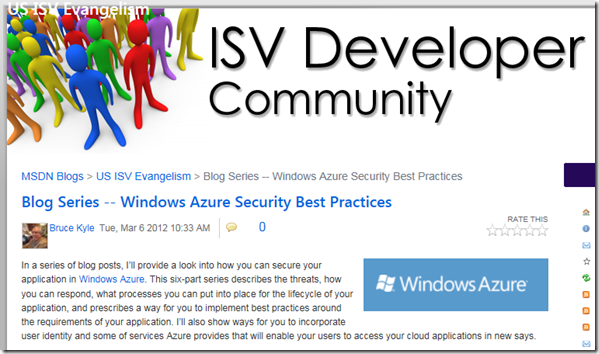Windows Azure Security Best Practices Blog Series
My colleague Brue Kyle has published a blog series on Windows Azure security best practices. You can find more detail here.
Here are the links to each part in this series:
Windows Azure Security Best Practices -- Part 1: The Challenges, Defense in Depth. This post describes the threat landscape and introduces the plan for your application to employ defense in depth in partnership with Windows Azure.
Windows Azure Security Best Practices -- Part 2: What Azure Provides Out-of-the-Box. This is an overview that security with Windows Azure is a shared responsibility, and Windows Azure provides your application with important security features. But then again, it also exposes other vulnerabilities that you should consider. In addition, I’ll explore how Microsoft approaches compliance.
Windows Azure Security Best Practices – Part 3: Identifying Your Security Frame. This post explores how you can examine your application and identify attack surfaces. The idea of a Security Frame is a way for you to look at your application to determine treats and your responses, before you even begin coding. I point you to checklists that you can use when you are architecting your application.
Windows Azure Security Best Practices – Part 4: What Else You Need to Do. In addition to protecting your application from threats, there are additional steps you should take when you deploy your application. We provide a list of mitigations that you should employ in your application development and deployment.
Upcoming
Windows Azure Security Best Practices – Part 5: Claims-Based Identity, Single Sign On. User identification represents the keys to accessing data and business processes in your application. In this section, I describe how you can separate user identity and the roles of your user out of your application and make it easier to create single sign on applications.
Windows Azure Security Best Practices – Part 6: How Azure Services Extends Your App Security. Finally, I show how other services in Windows Azure provide secure identity mapping, messaging, and connection to on premises application. This section suggests how you can use Windows Azure Active Directory, Windows Azure Connect, and Service Bus for your cloud applications, on premises applications, and hybrid applications.
